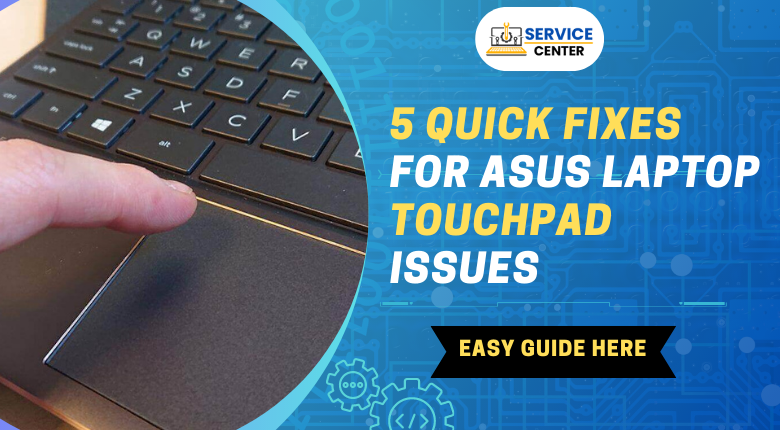5 Quick Fixes for Asus Laptop Touchpad Issues

Are you frustrated with touchpad issues on your Asus laptop? Asus Laptop Touchpad Issues can be a real annoyance, impacting your productivity and overall user experience. Fortunately, there are several quick fixes that can help you resolve these problems and get your touchpad working smoothly again. In this guide, we will explore five effective solutions specifically tailored to address touchpad issues on Asus laptops. By following these quick fixes, you can regain control over your touchpad and enjoy a seamless computing experience. Let’s dive in and discover how to overcome Asus Laptop Touchpad Issues with these easy troubleshooting techniques.
Restart the Laptop
When encountering Asus laptop touchpad issues, one of the simplest yet effective fixes is to restart your device. Restarting the laptop can often resolve minor software glitches that may be causing the touchpad problems. This quick and straightforward solution is worth trying before delving into more complex troubleshooting methods.
Instructions for Restarting an Asus Laptop
Save your work: Prioritize saving any unsaved documents or files to avoid losing data during the restart process.
Close all applications: Make sure to close all running applications and programs on your laptop.
Click on the “Start” button: Locate the Windows Start button at the bottom-left corner of your screen and click on it.
Select “Power” options: A menu will appear after clicking the Start button. Look for the “Power” or “Power Options” entry and click on it.
Choose “Restart”: Within the Power options, select the “Restart” option. This action will initiate the restart process.
Wait for the laptop to restart: Your Asus laptop will now begin the restart process. It may take a few moments to shut down and start up again.
Test the touchpad: Once your laptop has restarted, check if the touchpad issues have been resolved. Move your finger across the touchpad and observe its responsiveness.
Simplicity and Effectiveness of Restarting
Restarting your Asus laptop is a simple yet effective solution for addressing touchpad problems. It helps to reset the software and clear any temporary glitches that might be affecting the touchpad’s functionality. By shutting down and restarting the laptop, you allow the operating system and associated software to start fresh, potentially resolving any issues that were hindering the touchpad’s proper operation.
Moreover, restarting the laptop is a convenient fix that doesn’t require any technical expertise. Anyone can perform this action without the need for specialized tools or knowledge. It is a go-to solution that can save you time and effort when troubleshooting Asus laptop touchpad issues.
Check Touchpad Settings
One of the first steps to tackle Asus laptop touchpad issues is to check the touchpad settings on your Asus laptop. Sometimes, incorrect settings can cause touchpad problems, leading to unresponsiveness, erratic cursor movement, or accidental taps. By adjusting the touchpad settings, you can often restore its proper functionality and improve your overall user experience.
To begin, navigate to the touchpad settings on your Asus laptop. You can typically find this by accessing the “Control Panel” or “Settings” menu, depending on your Windows version. Look for the “Mouse” or “Touchpad” section, where you’ll find a range of customizable options.
Take a closer look at the settings and ensure that the touchpad is enabled. It may sound obvious, but sometimes accidental taps or gestures can accidentally disable the touchpad. If it’s disabled, simply enable it and see if the touchpad starts working again.
Next, check the sensitivity settings. Adjusting the sensitivity can help fine-tune the touchpad’s response to your touch, preventing accidental cursor movements. Experiment with different sensitivity levels until you find the one that suits your preferences.
Furthermore, explore additional touchpad options such as palm rejection and multi touch gestures. Palm rejection helps to distinguish between intentional touchpad movements and accidental palm or wrist touches, reducing false inputs. Meanwhile, multi touch gestures allow you to perform various actions using multiple fingers, enhancing your productivity.
By reviewing and adjusting the touchpad settings on your Asus laptop, you have a higher chance of resolving Asus laptop touchpad issues. These simple modifications can make a significant difference in the touchpad’s performance and alleviate common frustrations. Don’t hesitate to explore the settings and experiment with different configurations until you find the optimal setup for your specific needs.
Update or Reinstall Touchpad Drivers
When faced with frustrating Asus laptop touchpad issues, updating or reinstalling touchpad drivers can often provide a solution. Outdated or incompatible drivers can cause touchpad problems, resulting in unresponsive or erratic behavior. By ensuring you have the latest drivers installed or performing a driver reinstallation, you can address these issues and restore the functionality of your Asus laptop’s touchpad.
To update touchpad drivers, start by identifying the model and make of your touchpad. Visit the official Asus website and navigate to the “Support” or “Downloads” section. Enter the model number of your laptop and search for the touchpad drivers specifically. Download the latest version available and follow the installation instructions provided. Once the updated drivers are installed, restart your laptop and test the touchpad for improved performance.
Alternatively, if updating the drivers doesn’t resolve the touchpad issues, consider reinstalling them. To do this, access the “Device Manager” on your Asus laptop by right-clicking the Windows Start button and selecting “Device Manager” from the menu. Expand the “Mice and other pointing devices” category and locate your touchpad device. Right-click on it and select “Uninstall device”. Confirm the action and then restart your laptop. After the restart, Windows will automatically reinstall the touchpad drivers. Test the touchpad to see if the issues have been resolved.
Updating or reinstalling touchpad drivers is an effective troubleshooting technique to combat Asus laptop touchpad issues. By ensuring you have the latest drivers or performing a clean driver installation, you can resolve compatibility issues and improve the overall functionality of your Asus laptop’s touchpad. Remember to always download drivers from official sources to ensure compatibility and stability.
Clean the Touchpad
Asus laptop touchpad issues, it is essential to ensure that the touchpad is clean and free from dirt, dust, or debris. Over time, accumulated grime can interfere with the touchpad’s responsiveness, causing erratic cursor movements or unresponsiveness. Cleaning the touchpad of your Asus laptop is a simple yet effective fix that can significantly improve its functionality.
To clean the touchpad, start by shutting down the laptop and disconnecting it from any power source. Use a soft, lint-free cloth slightly dampened with water or a mild cleaning solution. Gently wipe the touchpad’s surface in a circular motion to remove any dirt or smudges. Avoid using excessive water or harsh chemicals, as they may damage the touchpad’s sensitive surface.
For hard-to-reach areas around the touchpad, you can use a soft brush or a compressed air can to blow away dust particles. Be gentle and ensure not to apply too much pressure, as the touchpad is a delicate component.
Once you have cleaned the touchpad, allow it to air dry for a few minutes before turning on your Asus laptop. Test the touchpad to see if the cleaning has resolved any responsiveness issues or erratic behavior.
By incorporating regular touchpad cleaning into your laptop maintenance routine, you can prevent potential touchpad issues and enjoy a smoother user experience. A clean touchpad can make a noticeable difference in how efficiently you can navigate and interact with your Asus laptop.
Perform a System Restore
Performing a system restore on your Asus laptop can be an effective solution for addressing persistent Asus laptop touchpad issues. System restore allows you to revert your laptop’s settings and configuration to a previous state when the touchpad was functioning correctly. This process can help resolve touchpad issues caused by software conflicts or recent system changes.
Save your work: Prioritize saving any unsaved documents or files to avoid data loss during the system restore process.
Access the Control Panel: Click on the Windows Start button and search for “Control Panel.” Open it.
Open System Protection: Within the Control Panel, search for “System” and select “System Protection” from the results.
Choose System Restore: In the System Protection window, click on the “System Restore” button. This action will launch the System Restore wizard.
Select a Restore Point: The wizard will present you with a list of available restore points. Choose a restore point that predates the occurrence of the touchpad issues. It is advisable to select a restore point where the touchpad was working correctly.
Begin the System Restore: Follow the prompts in the wizard to confirm the restore point selection and start the system restore process. Your laptop will restart and begin restoring the selected settings and configurations.
Wait for the restoration: The system restore process may take some time. Allow your laptop to complete the restoration, and it will restart automatically when finished.
Test the touchpad: After the restart, check if the touchpad issues have been resolved. Move your finger across the touchpad and observe its responsiveness.
Read Also: What to Do When Your Laptop Won’t Turn On?
Conclusion
Asus laptop touchpad issues doesn’t have to be a daunting task. With the five quick fixes discussed above, you can regain control over your Asus laptop’s touchpad and enjoy a smoother computing experience. Restarting the laptop is a simple yet powerful way to resolve minor software glitches that may be affecting the touchpad. Checking the touchpad settings allows you to fine-tune its behavior and responsiveness to suit your preferences. Updating or reinstalling touchpad drivers ensures compatibility and stability, eliminating potential driver-related problems.







